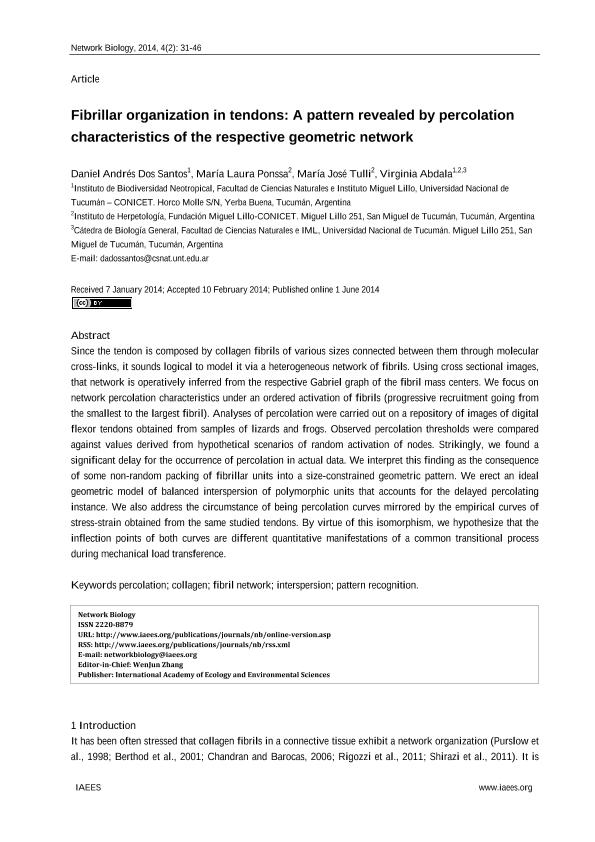Mostrar el registro sencillo del ítem
dc.contributor.author
Dos Santos, Daniel Andrés

dc.contributor.author
Ponssa, María Laura

dc.contributor.author
Tulli, María José

dc.contributor.author
Abdala, Virginia Sara Luz

dc.date.available
2017-02-13T21:49:34Z
dc.date.issued
2014
dc.identifier.citation
Dos Santos, Daniel Andrés; Ponssa, María Laura; Tulli, María José; Abdala, Virginia Sara Luz; Fibrillar organization in tendons: a pattern revealed by percolation characteristics of the respective geometric network; International Academy of Ecology and Environmental Sciences; Network Biology; 4; 2; -1-2014; 31-46
dc.identifier.issn
2220-8879
dc.identifier.uri
http://hdl.handle.net/11336/12955
dc.description.abstract
Since the tendon is composed by collagen fibrils of various sizes connected between them through molecular cross-links, it sounds logical to model it via a heterogeneous network of fibrils. Using cross sectional images, that network is operatively inferred from the respective Gabriel graph of the fibril mass centers. We focus on network percolation characteristics under an ordered activation of fibrils (progressive recruitment going from the smallest to the largest fibril). Analyses of percolation were carried out on a repository of images of digital flexor tendons obtained from samples of lizards and frogs. Observed percolation thresholds were compared against values derived from hypothetical scenarios of random activation of nodes. Strikingly, we found a significant delay for the occurrence of percolation in actual data. We interpret this finding as the consequence of some non-random packing of fibrillar units into a size-constrained geometric pattern. We erect an ideal geometric model of balanced interspersion of polymorphic units that accounts for the delayed percolating instance. We also address the circumstance of being percolation curves mirrored by the empirical curves of stress-strain obtained from the same studied tendons. By virtue of this isomorphism, we hypothesize that the inflection points of both curves are different quantitative manifestations of a common transitional process during mechanical load transference.
dc.format
application/pdf
dc.language.iso
eng
dc.publisher
International Academy of Ecology and Environmental Sciences
dc.rights
info:eu-repo/semantics/openAccess
dc.rights.uri
https://creativecommons.org/licenses/by/2.5/ar/
dc.subject
Percolation
dc.subject
Collagen
dc.subject
Fibril Network
dc.subject
Interspersion
dc.subject
Pattern Recognition
dc.subject.classification
Biología

dc.subject.classification
Ciencias Biológicas

dc.subject.classification
CIENCIAS NATURALES Y EXACTAS

dc.title
Fibrillar organization in tendons: a pattern revealed by percolation characteristics of the respective geometric network
dc.type
info:eu-repo/semantics/article
dc.type
info:ar-repo/semantics/artículo
dc.type
info:eu-repo/semantics/publishedVersion
dc.date.updated
2017-02-07T17:51:12Z
dc.journal.volume
4
dc.journal.number
2
dc.journal.pagination
31-46
dc.journal.pais
Hong Kong

dc.description.fil
Fil: Dos Santos, Daniel Andrés. Consejo Nacional de Investigaciones Cientificas y Tecnicas. Centro Cientifico Tecnologico Tucuman. Instituto de Biodiversidad Neotropical; Argentina. Universidad Nacional de Tucumán. Facultad de Ciencias Naturales e Instituto Miguel Lillo; Argentina
dc.description.fil
Fil: Ponssa, María Laura. Fundación Miguel Lillo. Dirección de Zoología. Instituto de Herpetología; Argentina. Consejo Nacional de Investigaciones Científicas y Técnicas; Argentina
dc.description.fil
Fil: Tulli, María José. Fundación Miguel Lillo. Dirección de Zoología. Instituto de Herpetología; Argentina. Consejo Nacional de Investigaciones Científicas y Técnicas; Argentina
dc.description.fil
Fil: Abdala, Virginia Sara Luz. Consejo Nacional de Investigaciones Cientificas y Tecnicas. Centro Cientifico Tecnologico Tucuman. Instituto de Biodiversidad Neotropical; Argentina. Universidad Nacional de Tucumán. Facultad de Ciencias Naturales e Instituto Miguel Lillo; Argentina. Fundación Miguel Lillo. Dirección de Zoología. Instituto de Herpetología; Argentina
dc.journal.title
Network Biology
dc.relation.alternativeid
info:eu-repo/semantics/altIdentifier/url/http://www.iaees.org/publications/journals/nb/articles/2014-4(2)/fibrillar-organization-in-tendons.pdf
Archivos asociados
